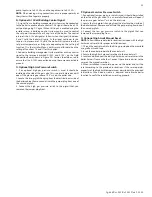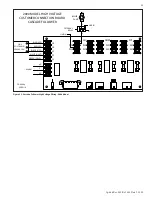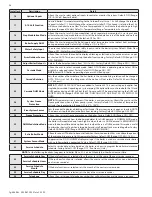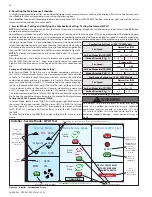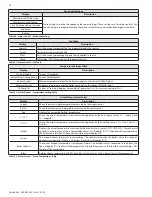
lp-666 Rev. 003 Rel. 001 Date 2.25.20
47
Part 10 - Start-Up Preparation
WARNING
!
Thoroughly clean and flush any system that has used glycol before
installing the boiler. Provide the customer with a material safety data
sheet (MSDS) on the fluid used.
A. Check / Control Water Chemistry
Chemical imbalance of your water can cause severe damage to your
boiler and associated equipment, and may also affect efficiency.
You may have to have your water quality professionally analyzed
to determine whether you need to install a water softener. It is
important that the water chemistry on both the domestic hot water
and central heating sides are checked before installing the boiler, as
water quality will affect the reliability of the system. Outlined below
are those water quality parameters which need to be met in order
for the system to operate efficiently for many years. Failure of a heat
exchanger due to lime scale build-up on the heating surface, low pH
or other imbalance IS NOT covered by the warranty.
CAUTION
To assure extended service life, it is recommended to test water quality
prior to installation. Listed below are some guidelines.
Do not use petroleum-based cleaning or sealing compounds in the
boiler system. Damage to elastomer seals and gaskets in the system
could occur, resulting in substantial property damage.
CAUTION
Closed loop water must be free of corrosive chemicals, sand, dirt, and
other contaminates. It is up to the installer to ensure the water does
not contain corrosive chemicals or elements that can damage the heat
exchanger.
If you suspect that your water is contaminated in any way, discontinue
use of the appliance and contact an authorized technician or licensed
professional.
• Water pH between 6.5 and 8.5
• Hardness less than 5 - 12 grains (71.3 - 205 mg/L)
• Chloride concentration less than 150 ppm (mg/L)
• Total Dissolved Solids (TDS) 100 - 450 ppm (mg/L)
*NOTE:
It is recommended to clean the heat exchanger at least once
a year to prevent lime scale buildup. To clean the heat exchanger,
follow the maintenance procedure in this manual.
Clean system to remove sediment*
1. You must thoroughly flush the system (without boiler connected)
to remove sediment. The high-efficiency heat exchanger can be
damaged by buildup or corrosion due to sediment.
2. For zoned systems, flush each zone separately through a purge
valve. (If purge valves and isolation valves are not already installed,
install them to properly clean the system.)
3. Flush system until water runs clean and you are sure piping is free
of sediment.
*NOTE:
It is recommended you clean heat exchanger at least once a
year to prevent lime scale buildup. Follow the maintenance procedure
to clean the heat exchanger in the Maintenance Section of this manual.
Test/replace freeze protection fluid
1. For systems using freeze protection fluids, follow fluid manufacturer’s
instructions to verify inhibitor level and that other fluid characteristics
are satisfactory.
2. Freeze protection fluid must be replaced periodically due to
degradation of inhibitors over time. Follow all fluid manufacturer
instructions.
NOTE: Boiler failure due to improper water chemistry is not
covered by warranty.
B. Check for Gas Leaks
WARNING
!
Before starting the boiler, and during initial operation, smell near
the floor and around the boiler for gas odorant or any unusual odor.
Remove boiler front door and smell interior of boiler enclosure. Do
not proceed with startup if there is any indication of a gas leak.
Repair any leaks at once.
C. Freeze Protection (When Used)
1. Determine the freeze protection fluid quantity using total system
water content following the fluid manufacturer’s instructions.
Remember to include expansion tank water content.
2. Local codes may require back flow preventer or actual disconnect
from city water supply.
3. When using freeze protection fluid with automatic fill, install
a water meter to monitor water makeup. Freeze protection fluid
concentration may drop if there is a leak, reducing the freeze
protection level.
WARNING
!
NEVER use automotive or standard glycol antifreeze. Do not use
ethylene glycol made for hydronic systems. Use only freeze-
protection fluids certified by fluid manufacturer as suitable for
use with stainless steel boilers, verified in the fluid manufacturer’s
literature. Thoroughly clean and flush any system that has used
glycol before installing the new boiler. Provide the boiler owner
with a material safety data sheet (MSDS) on the fluid used.
D. Fill and Test Water System
WARNING
!
Ensure the boiler is full of water before firing the burner. Failure
to do so will damage the boiler. Such damage IS NOT covered by
warranty, and could result in property damage, severe personal
injury, or death.
1. Fill the system only after ensuring water chemistry meets the
requirements listed in this manual.
2. Close the manual and automatic air vents and boiler drain valve.
3. Fill to the correct system pressure. Correct pressure will vary with
each application.
a. Typical cold water fill pressure for a residential system is 12 psi.
b. Pressure will rise when boiler is turned on and system water
temperature increases. Operating pressure must never exceed the
relief valve pressure setting.
4. At initial fill and during boiler startup and testing, check system
thoroughly for leaks. Repair all leaks before proceeding further.
Eliminate all system leaks. Continual fresh make-up water will
reduce boiler life. Minerals can build up in the heat exchanger,
reducing heat transfer, overheating the heat exchanger and
causing heat exchanger failure.
5. The system may have residual substances that could affect
water chemistry. After the system has been filled and leak tested,
verify that water pH and chloride concentrations are acceptable by
sample testing.
It is important to purge the system of air to avoid damage to the
boiler.
CAUTION
CAUTION
PROPANE ONLY – The propane supplier mixes an odorant with the
propane to make its presence detectable. In some instances the
odorant can fade, and the gas may no longer have an odor. Before
startup (and periodically thereafter), have the propane supplier
verify the correct odorant level in the gas.

